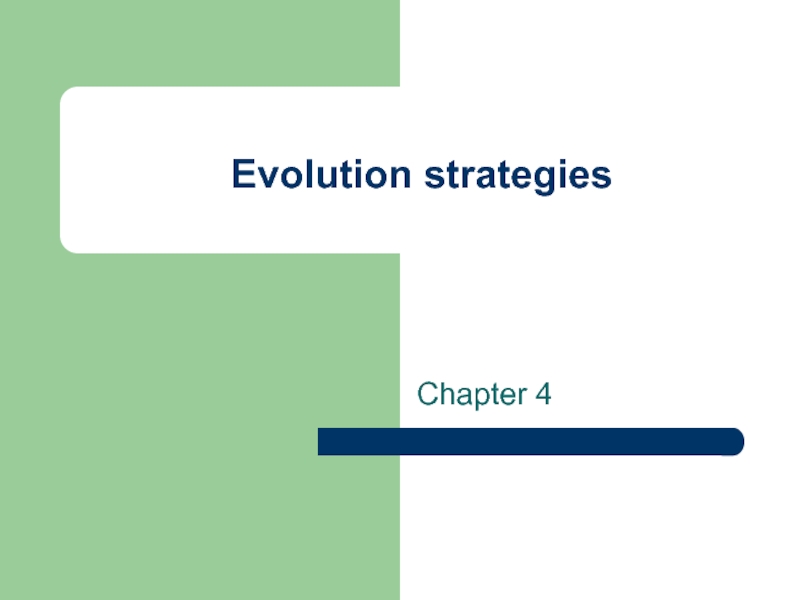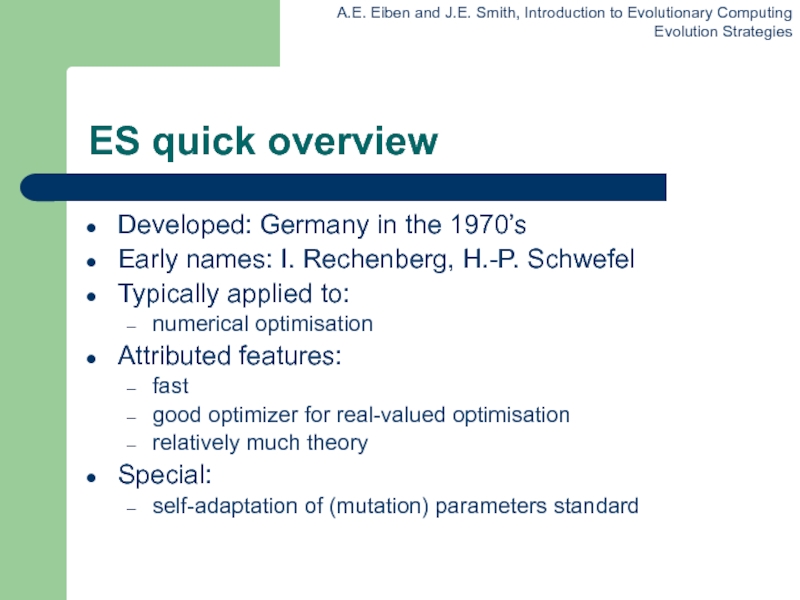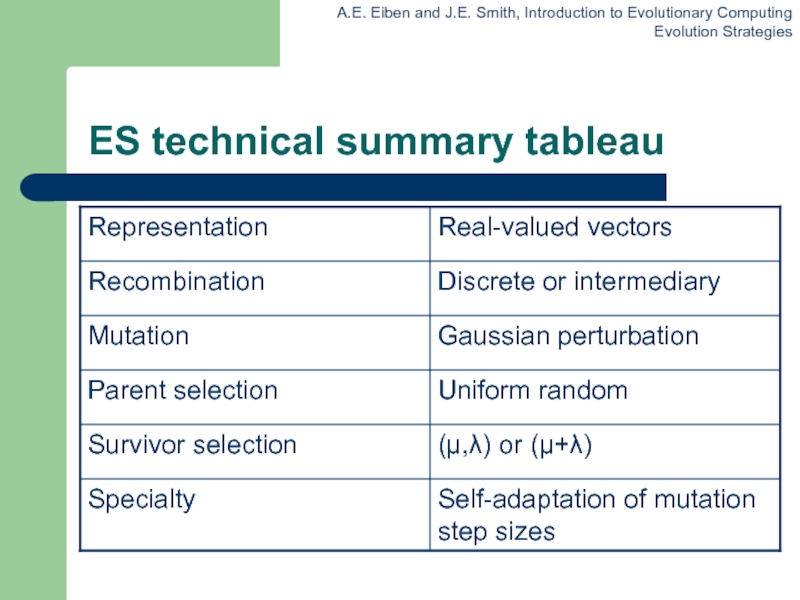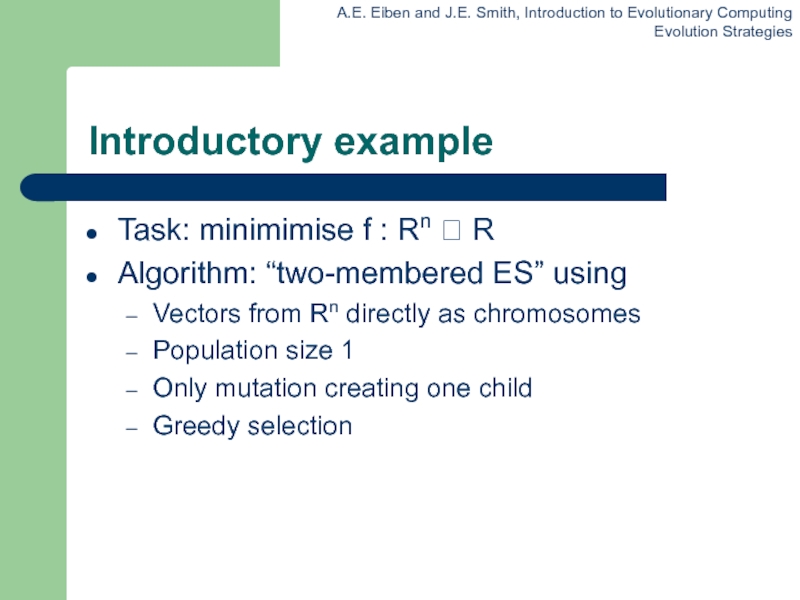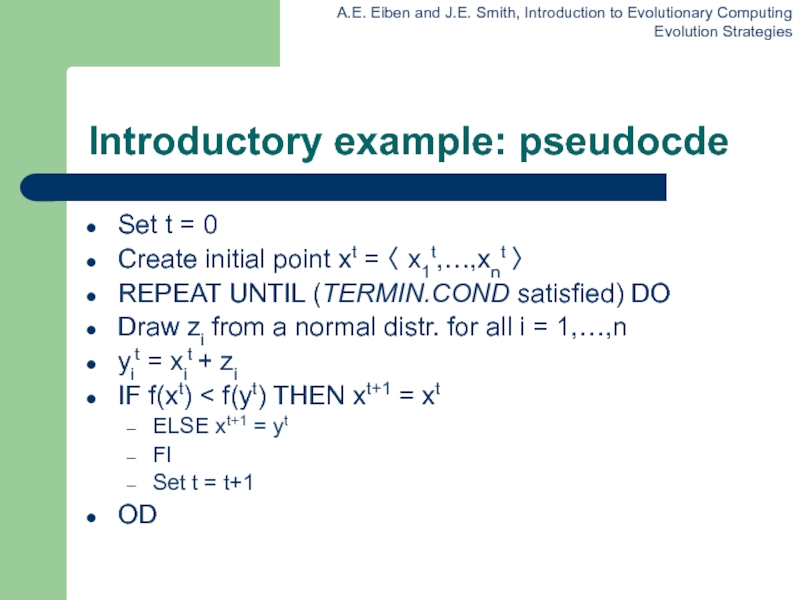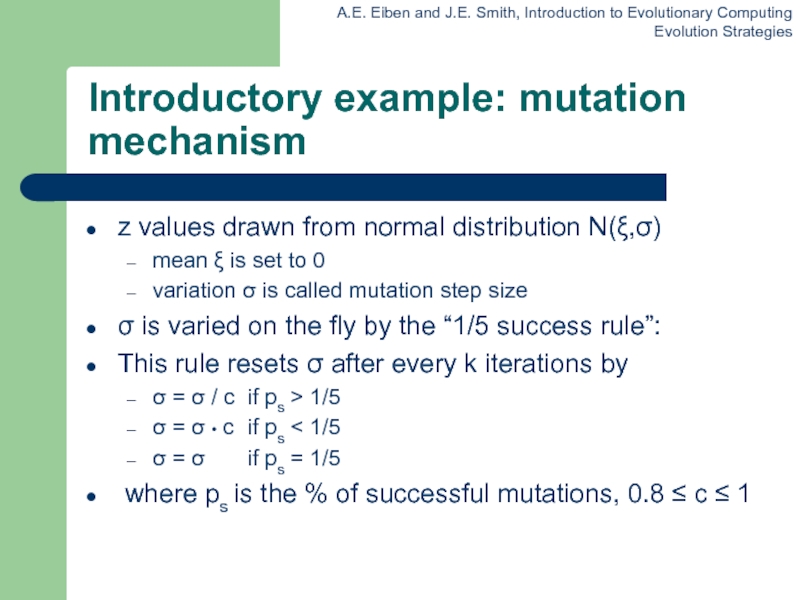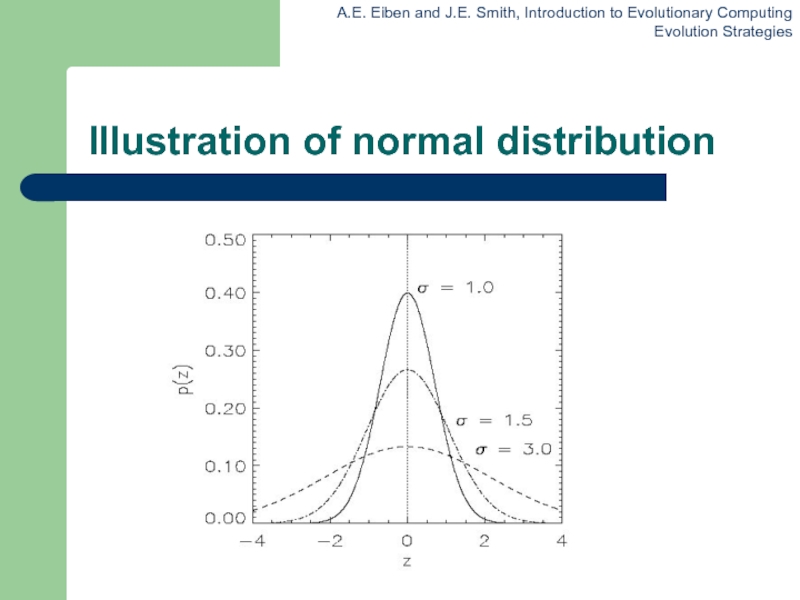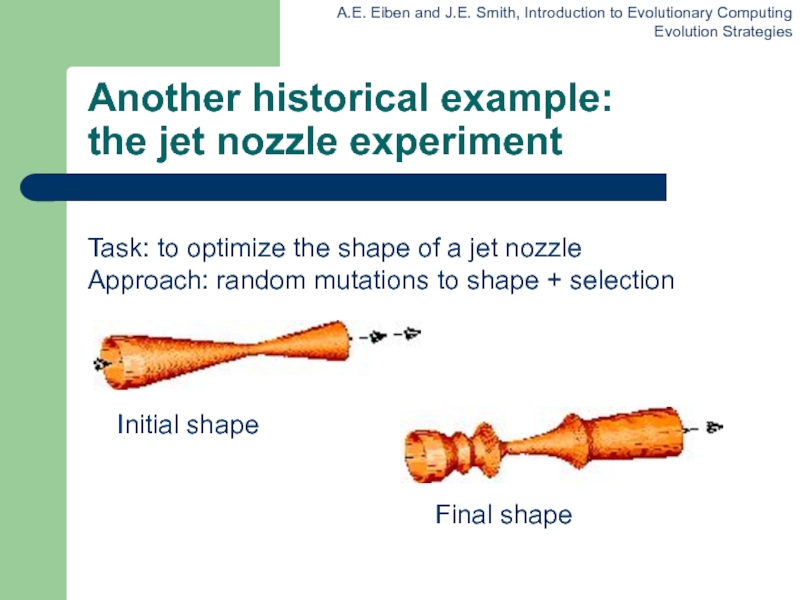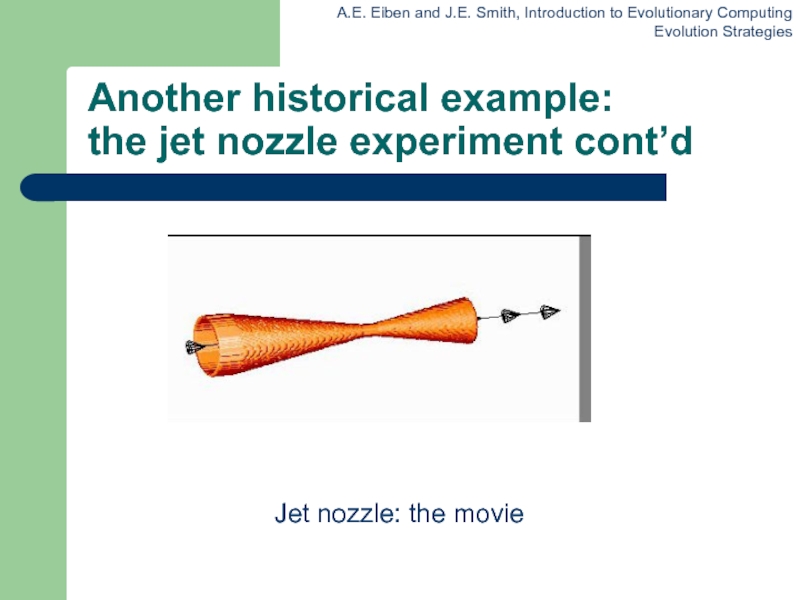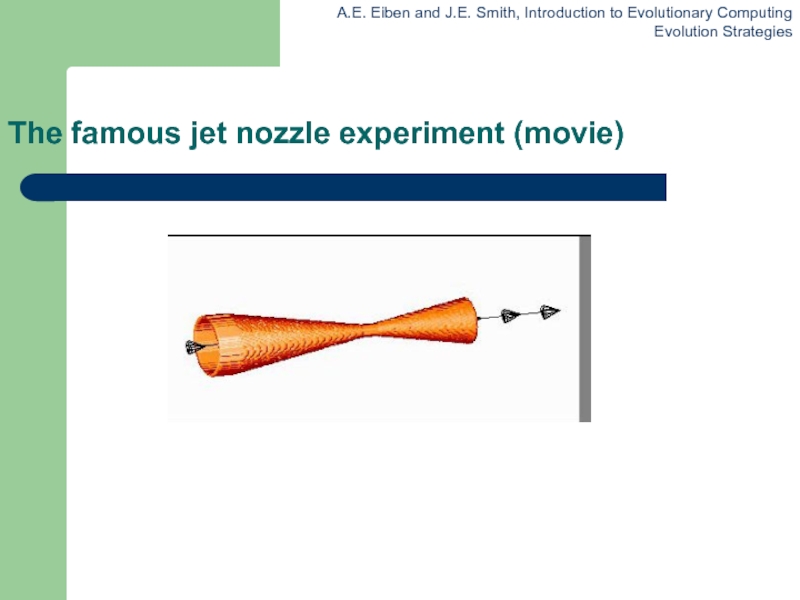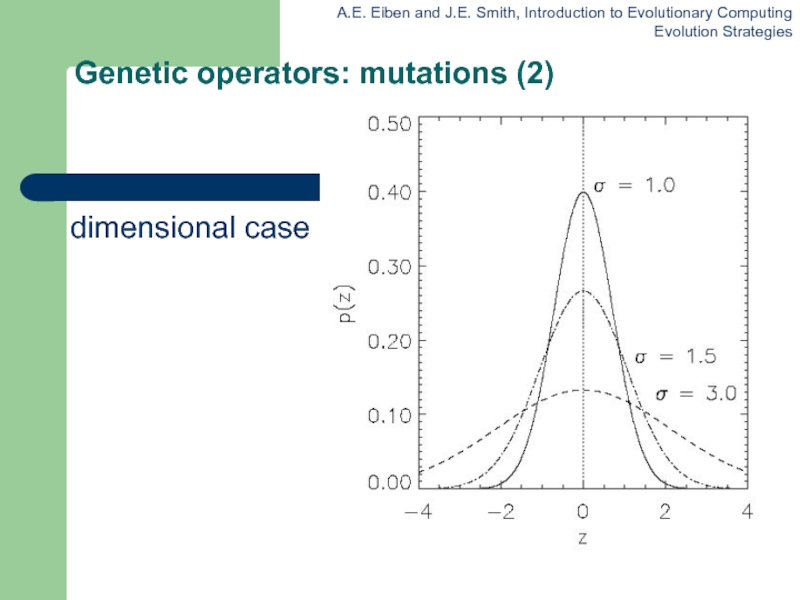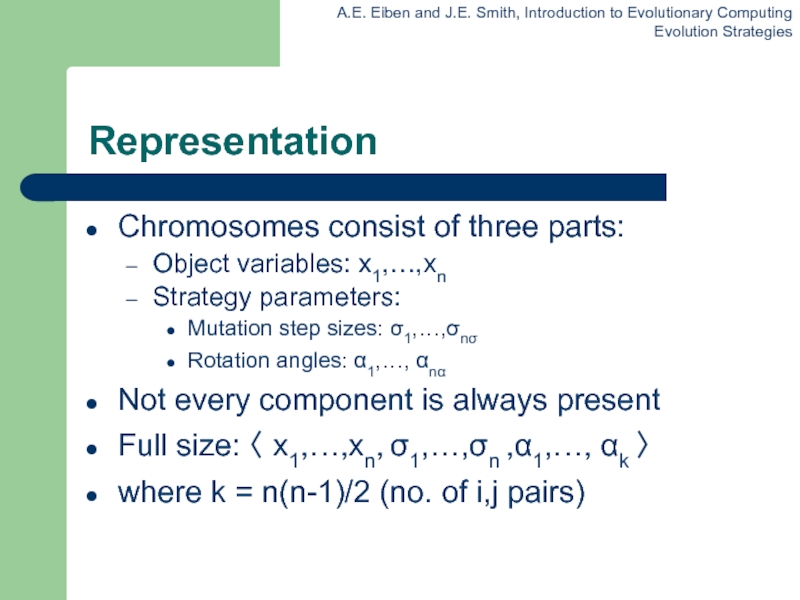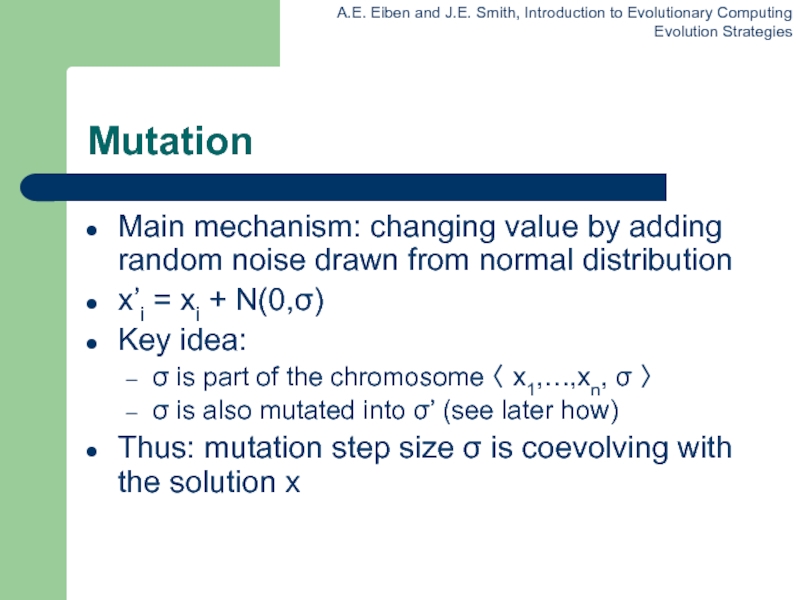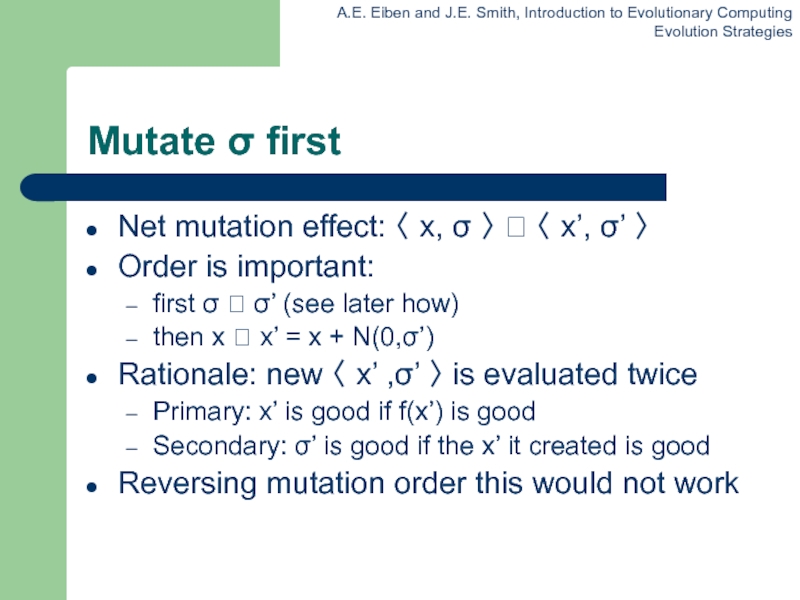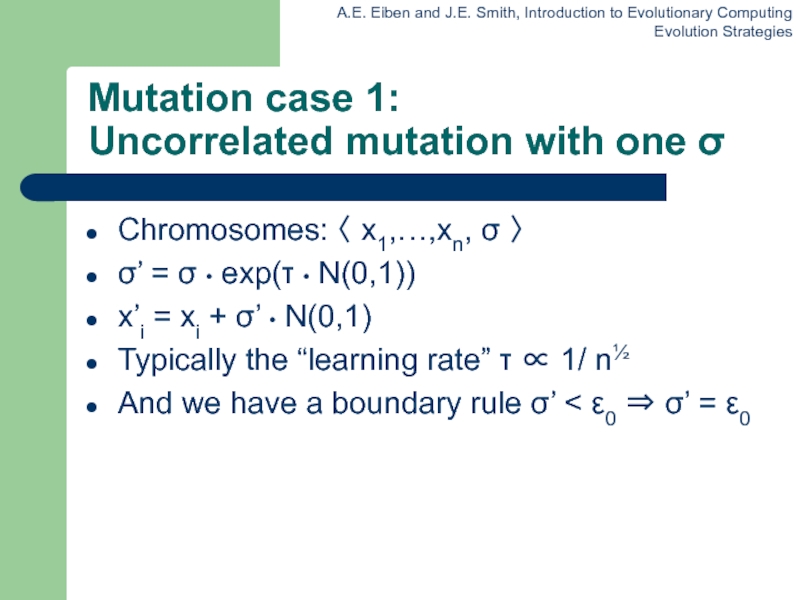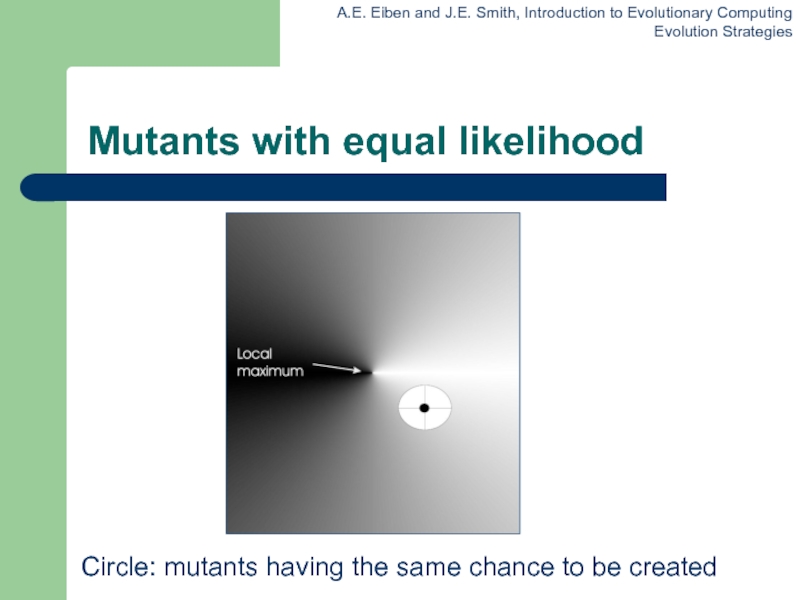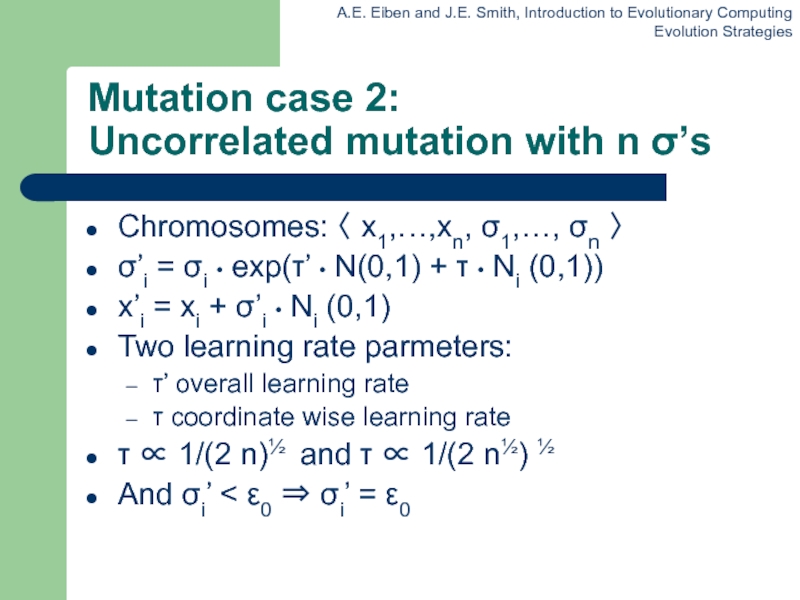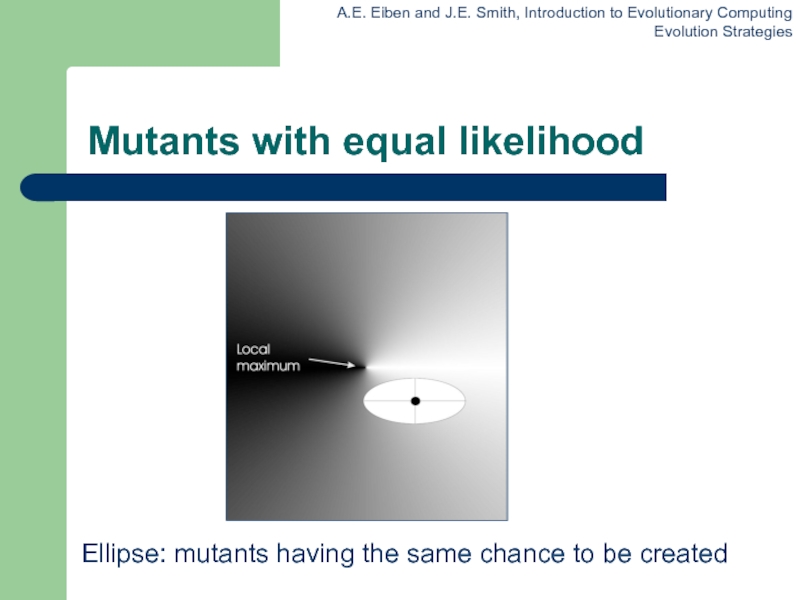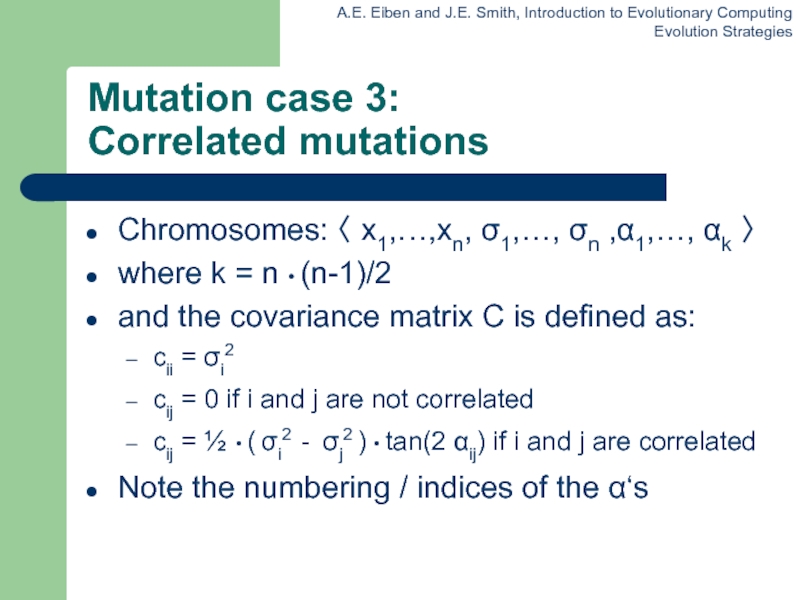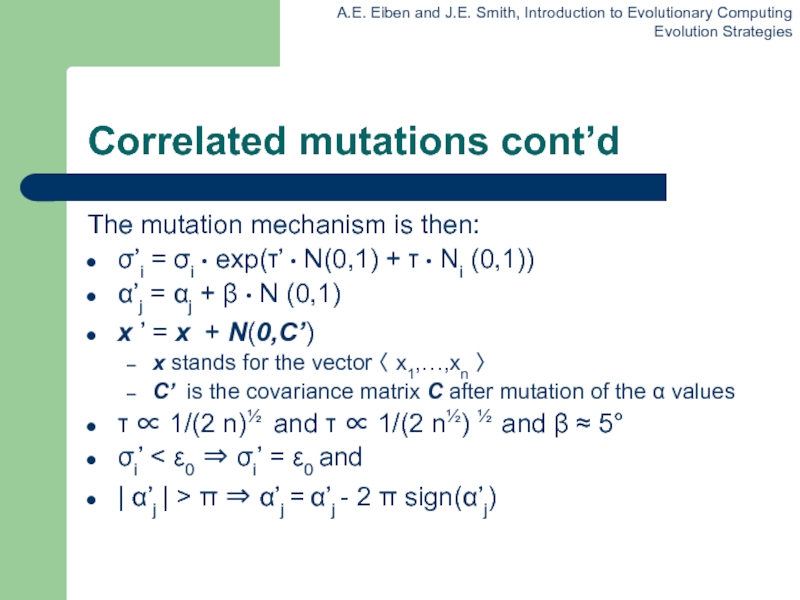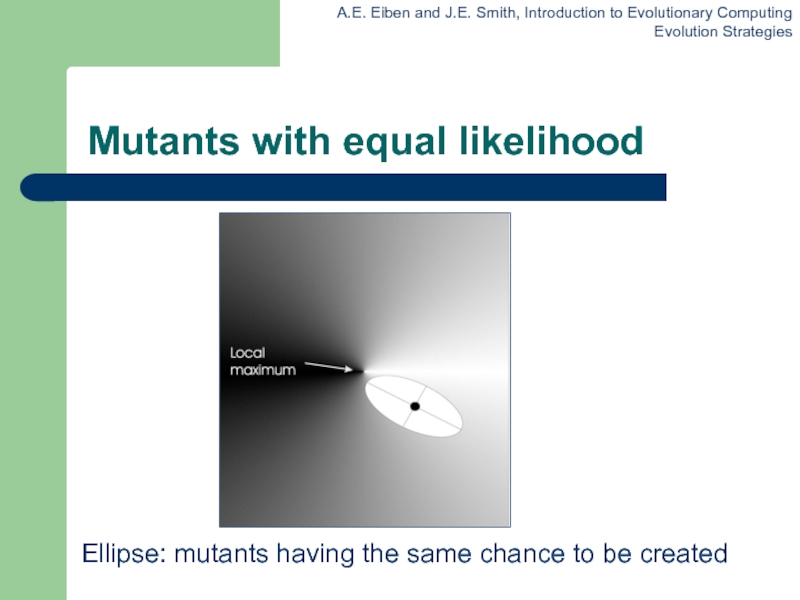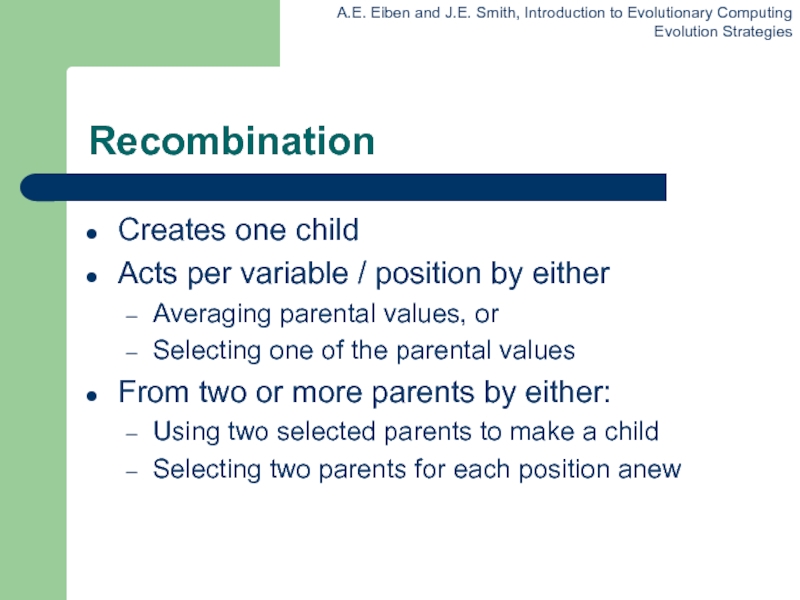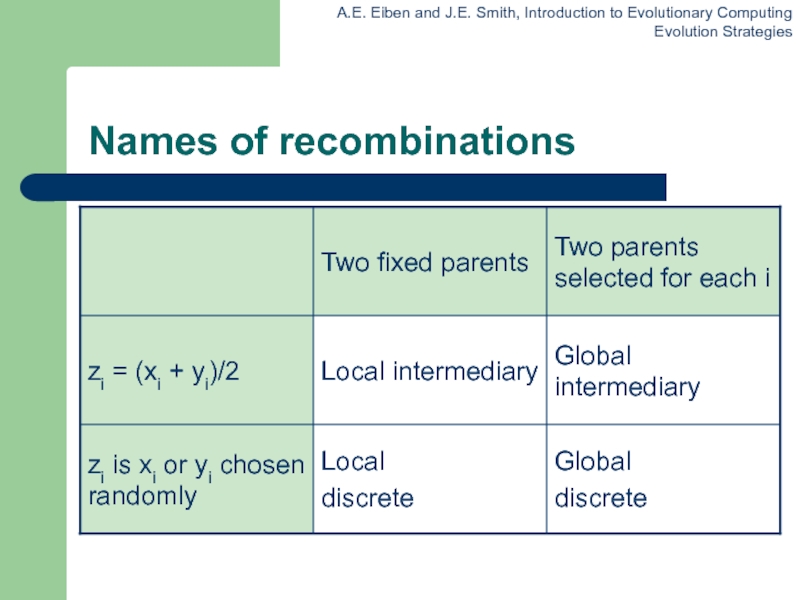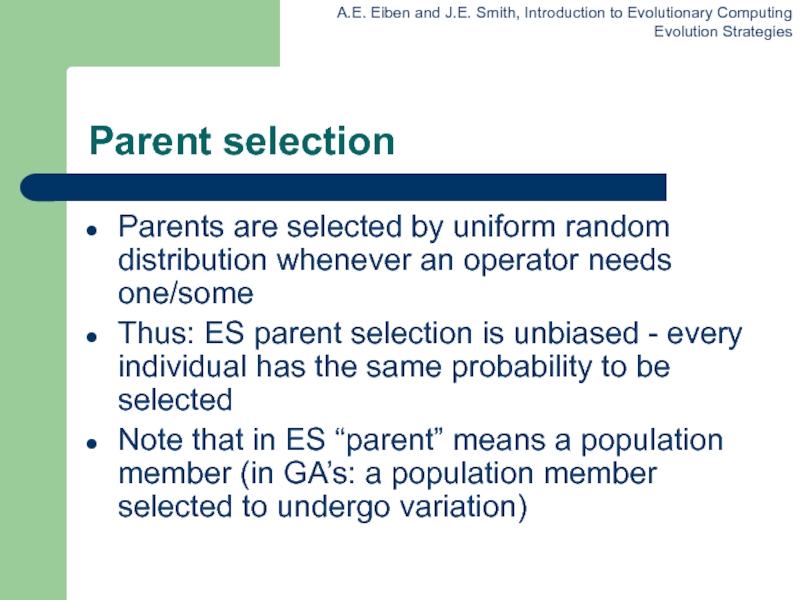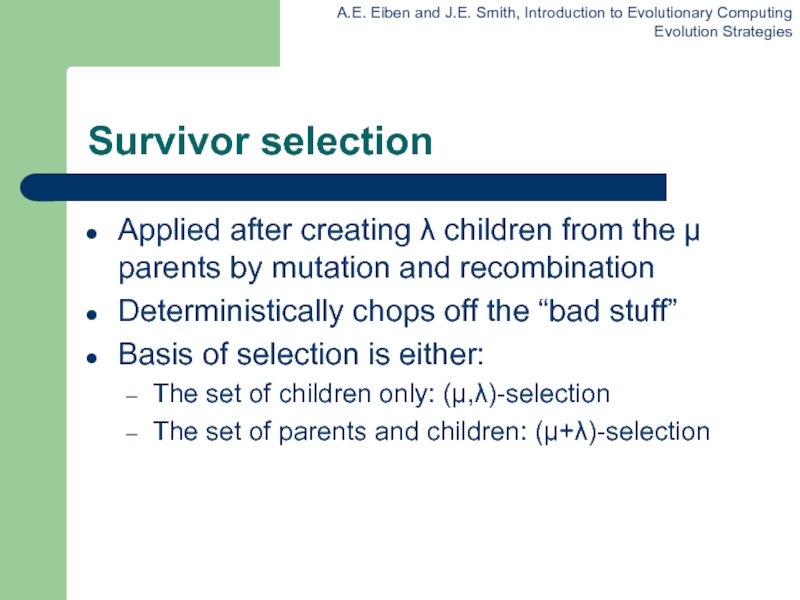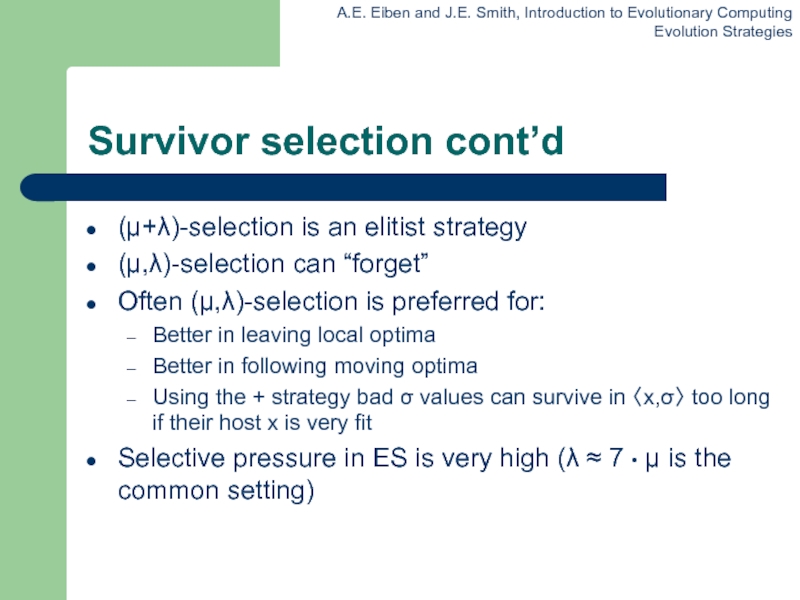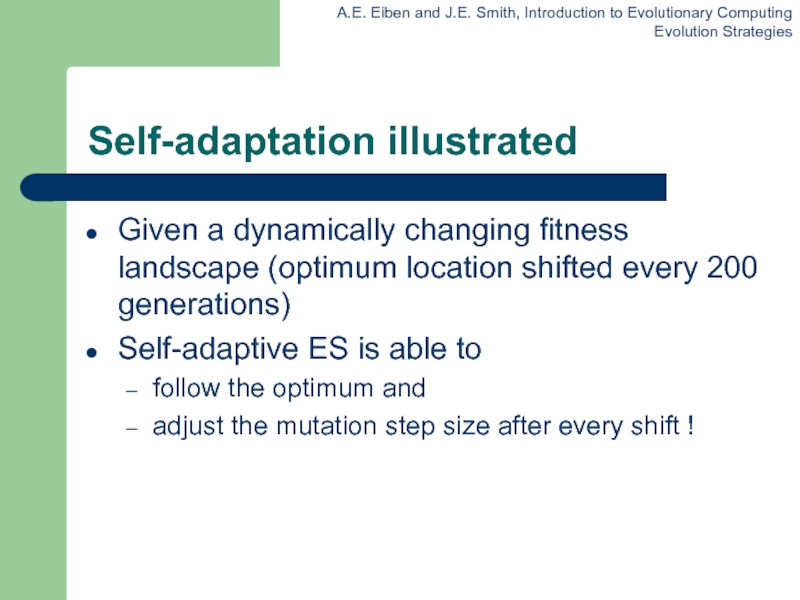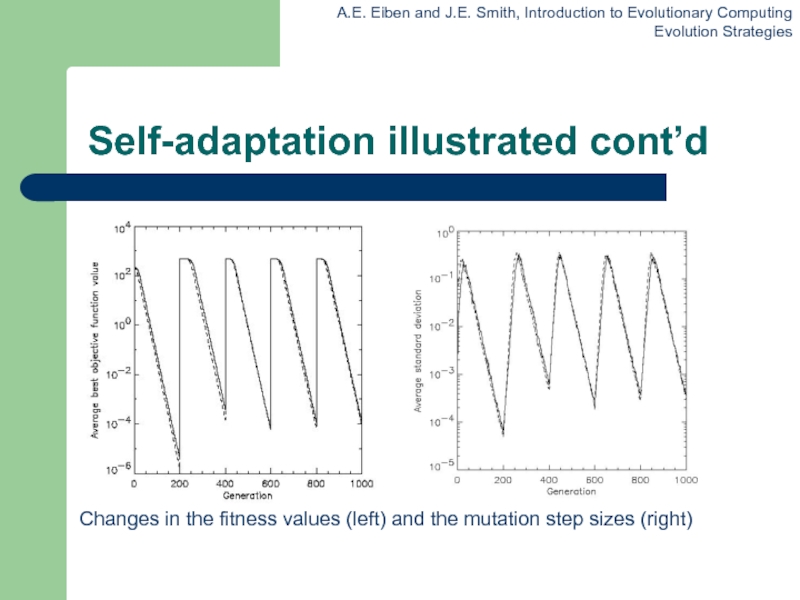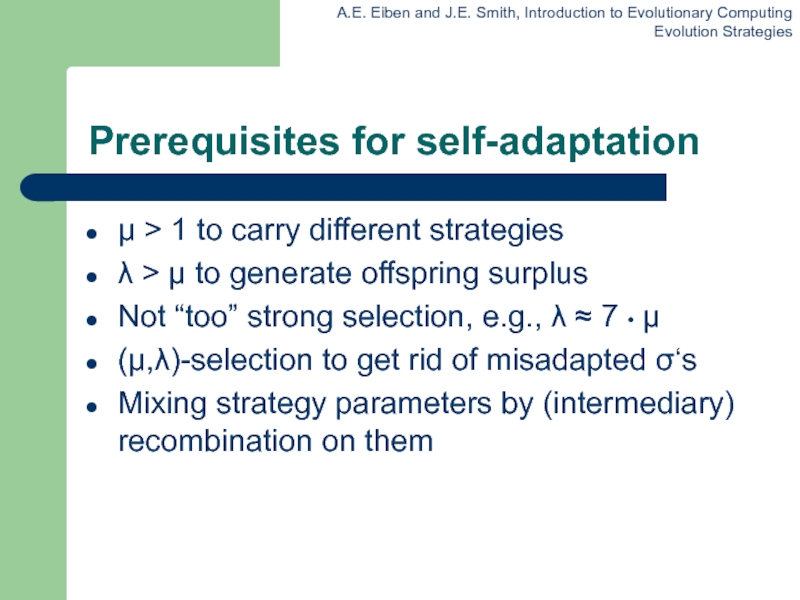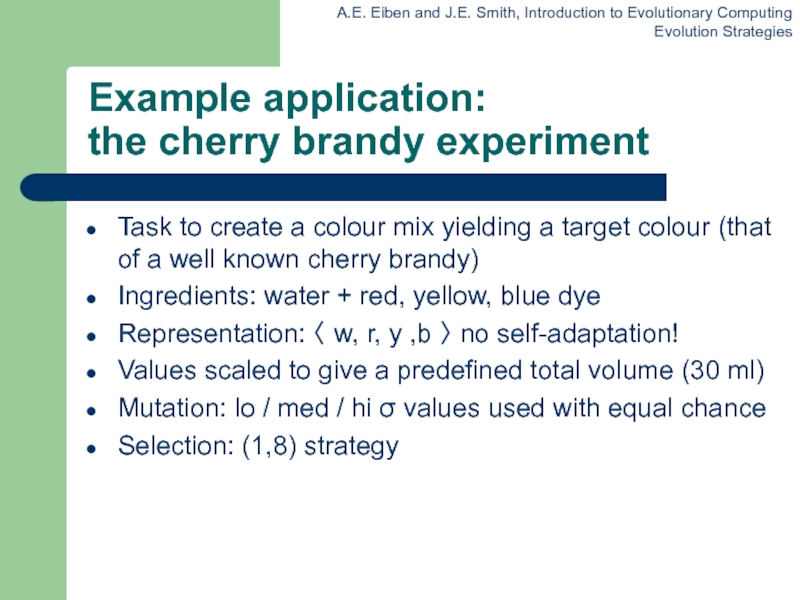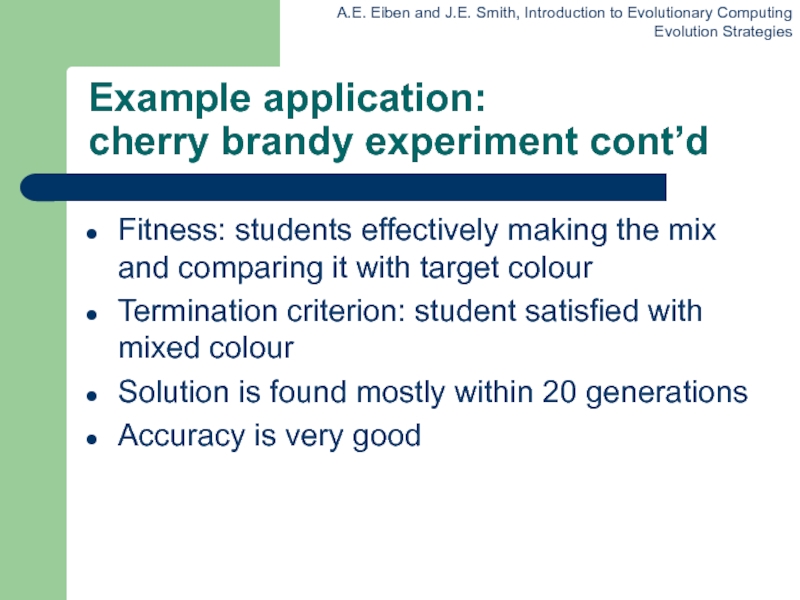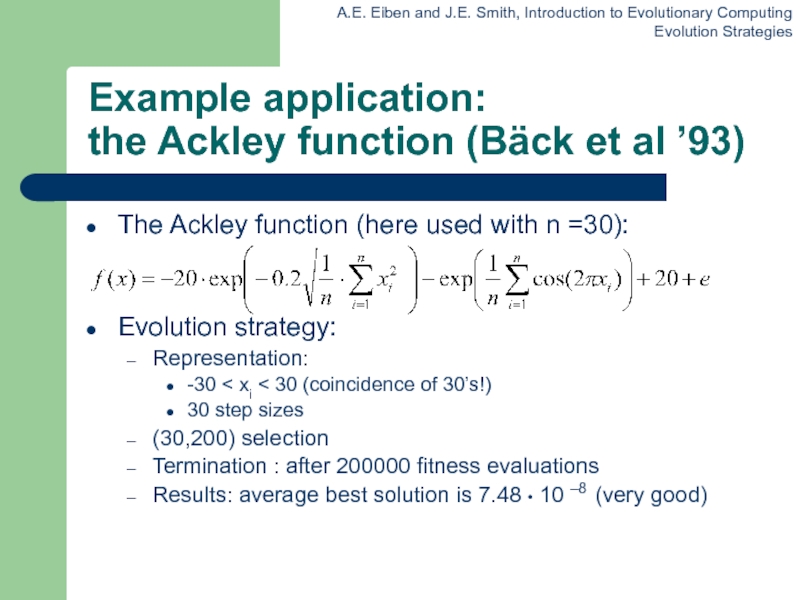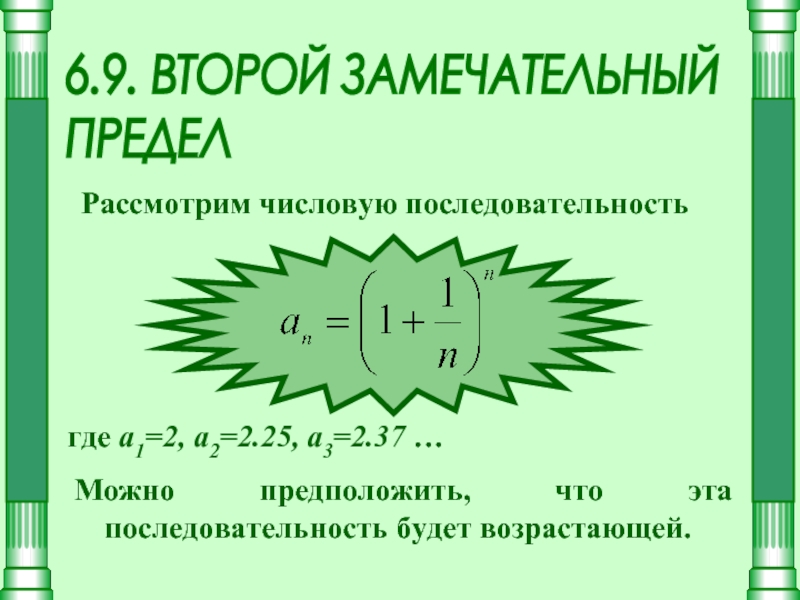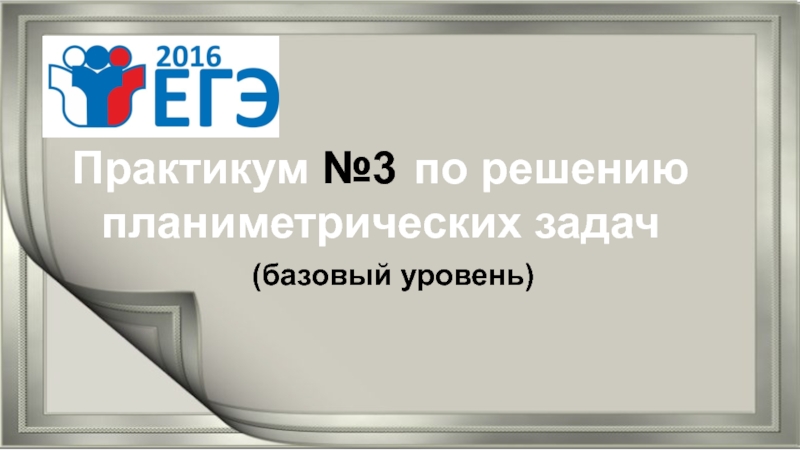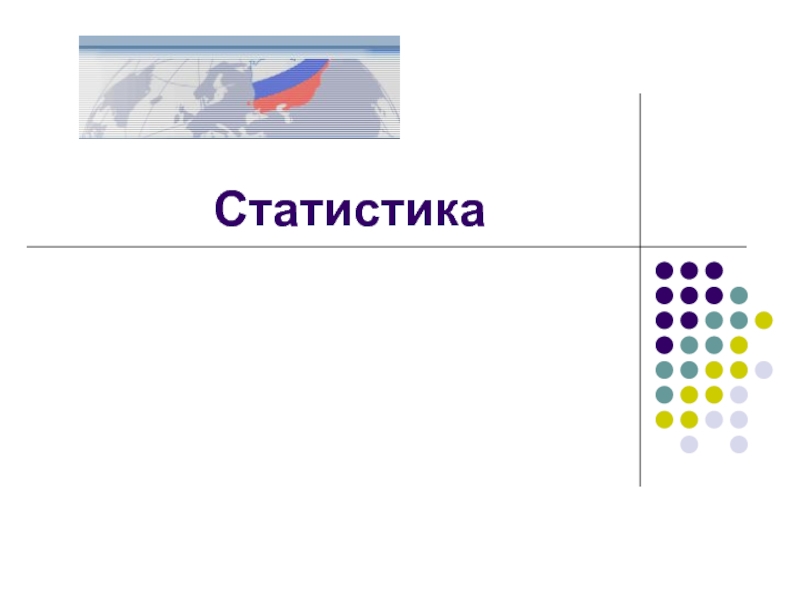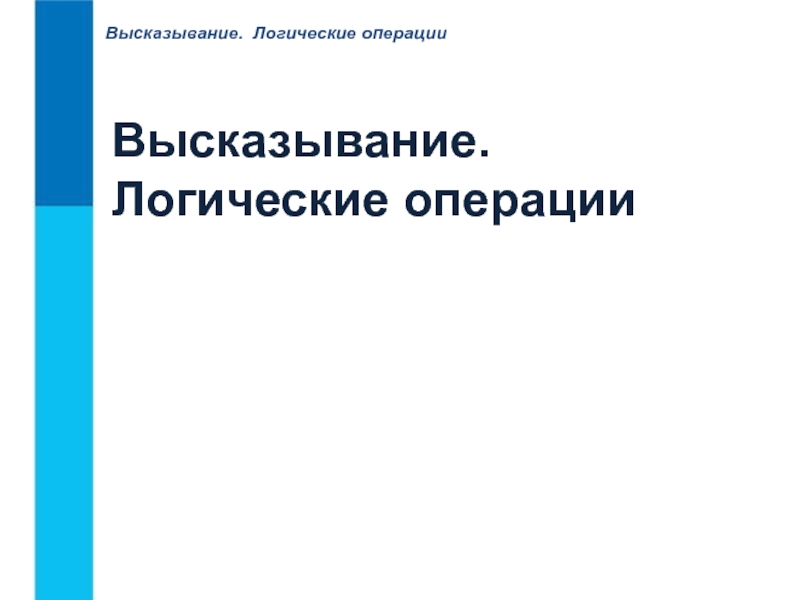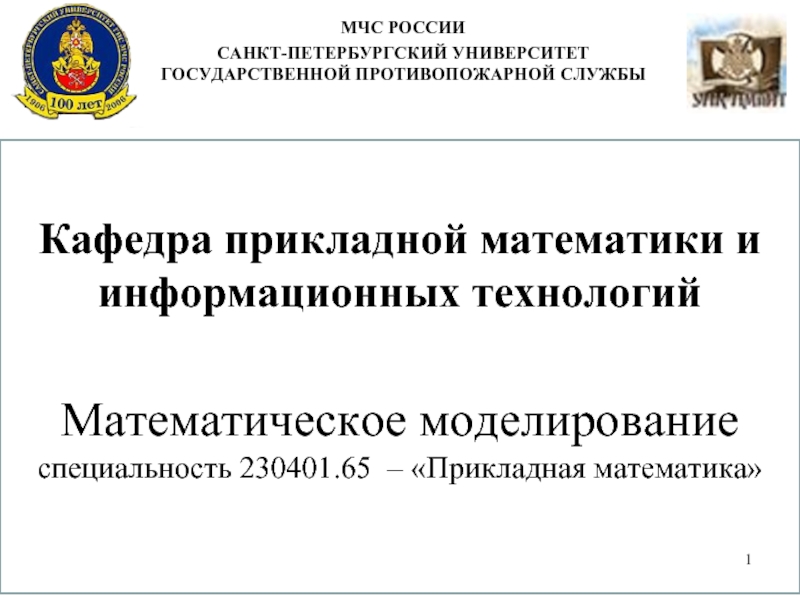- Главная
- Разное
- Дизайн
- Бизнес и предпринимательство
- Аналитика
- Образование
- Развлечения
- Красота и здоровье
- Финансы
- Государство
- Путешествия
- Спорт
- Недвижимость
- Армия
- Графика
- Культурология
- Еда и кулинария
- Лингвистика
- Английский язык
- Астрономия
- Алгебра
- Биология
- География
- Детские презентации
- Информатика
- История
- Литература
- Маркетинг
- Математика
- Медицина
- Менеджмент
- Музыка
- МХК
- Немецкий язык
- ОБЖ
- Обществознание
- Окружающий мир
- Педагогика
- Русский язык
- Технология
- Физика
- Философия
- Химия
- Шаблоны, картинки для презентаций
- Экология
- Экономика
- Юриспруденция
Evolution strategies. Chapter 4 презентация
Содержание
- 1. Evolution strategies. Chapter 4
- 2. ES quick overview Developed: Germany in the
- 3. ES technical summary tableau
- 4. Introductory example Task: minimimise f : Rn
- 5. Introductory example: pseudocde Set t = 0
- 6. Introductory example: mutation mechanism z values drawn
- 7. Illustration of normal distribution
- 8. Another historical example: the jet nozzle experiment
- 9. Another historical example: the jet nozzle experiment cont’d Jet nozzle: the movie
- 10. The famous jet nozzle experiment (movie)
- 11. Genetic operators: mutations (2) The one dimensional case
- 12. Representation Chromosomes consist of three parts: Object
- 13. Mutation Main mechanism: changing value by adding
- 14. Mutate σ first Net mutation effect: 〈
- 15. Mutation case 1: Uncorrelated mutation with one
- 16. Mutants with equal likelihood Circle: mutants having the same chance to be created
- 17. Mutation case 2: Uncorrelated mutation with n
- 18. Mutants with equal likelihood Ellipse: mutants having the same chance to be created
- 19. Mutation case 3: Correlated mutations Chromosomes:
- 20. Correlated mutations cont’d The mutation mechanism is
- 21. Mutants with equal likelihood Ellipse: mutants having the same chance to be created
- 22. Recombination Creates one child Acts per variable
- 23. Names of recombinations
- 24. Parent selection Parents are selected by uniform
- 25. Survivor selection Applied after creating λ children
- 26. Survivor selection cont’d (μ+λ)-selection is an elitist
- 27. Self-adaptation illustrated Given a dynamically changing fitness
- 28. Self-adaptation illustrated cont’d Changes in the fitness values (left) and the mutation step sizes (right)
- 29. Prerequisites for self-adaptation μ > 1
- 30. Example application: the cherry brandy experiment
- 31. Example application: cherry brandy experiment cont’d
- 32. Example application: the Ackley function (Bäck
Слайд 2ES quick overview
Developed: Germany in the 1970’s
Early names: I. Rechenberg, H.-P.
Schwefel
Typically applied to:
numerical optimisation
Attributed features:
fast
good optimizer for real-valued optimisation
relatively much theory
Special:
self-adaptation of (mutation) parameters standard
Typically applied to:
numerical optimisation
Attributed features:
fast
good optimizer for real-valued optimisation
relatively much theory
Special:
self-adaptation of (mutation) parameters standard
Слайд 4Introductory example
Task: minimimise f : Rn ? R
Algorithm: “two-membered ES” using
Vectors from Rn directly as chromosomes
Population size 1
Only mutation creating one child
Greedy selection
Слайд 5Introductory example: pseudocde
Set t = 0
Create initial point xt = 〈
x1t,…,xnt 〉
REPEAT UNTIL (TERMIN.COND satisfied) DO
Draw zi from a normal distr. for all i = 1,…,n
yit = xit + zi
IF f(xt) < f(yt) THEN xt+1 = xt
ELSE xt+1 = yt
FI
Set t = t+1
OD
REPEAT UNTIL (TERMIN.COND satisfied) DO
Draw zi from a normal distr. for all i = 1,…,n
yit = xit + zi
IF f(xt) < f(yt) THEN xt+1 = xt
ELSE xt+1 = yt
FI
Set t = t+1
OD
Слайд 6Introductory example: mutation mechanism
z values drawn from normal distribution N(ξ,σ)
mean
ξ is set to 0
variation σ is called mutation step size
σ is varied on the fly by the “1/5 success rule”:
This rule resets σ after every k iterations by
σ = σ / c if ps > 1/5
σ = σ • c if ps < 1/5
σ = σ if ps = 1/5
where ps is the % of successful mutations, 0.8 ≤ c ≤ 1
variation σ is called mutation step size
σ is varied on the fly by the “1/5 success rule”:
This rule resets σ after every k iterations by
σ = σ / c if ps > 1/5
σ = σ • c if ps < 1/5
σ = σ if ps = 1/5
where ps is the % of successful mutations, 0.8 ≤ c ≤ 1
Слайд 8Another historical example:
the jet nozzle experiment
Task: to optimize the shape of
a jet nozzle
Approach: random mutations to shape + selection
Approach: random mutations to shape + selection
Слайд 12Representation
Chromosomes consist of three parts:
Object variables: x1,…,xn
Strategy parameters:
Mutation step sizes: σ1,…,σnσ
Rotation
angles: α1,…, αnα
Not every component is always present
Full size: 〈 x1,…,xn, σ1,…,σn ,α1,…, αk 〉
where k = n(n-1)/2 (no. of i,j pairs)
Not every component is always present
Full size: 〈 x1,…,xn, σ1,…,σn ,α1,…, αk 〉
where k = n(n-1)/2 (no. of i,j pairs)
Слайд 13Mutation
Main mechanism: changing value by adding random noise drawn from normal
distribution
x’i = xi + N(0,σ)
Key idea:
σ is part of the chromosome 〈 x1,…,xn, σ 〉
σ is also mutated into σ’ (see later how)
Thus: mutation step size σ is coevolving with the solution x
x’i = xi + N(0,σ)
Key idea:
σ is part of the chromosome 〈 x1,…,xn, σ 〉
σ is also mutated into σ’ (see later how)
Thus: mutation step size σ is coevolving with the solution x
Слайд 14Mutate σ first
Net mutation effect: 〈 x, σ 〉 ? 〈
x’, σ’ 〉
Order is important:
first σ ? σ’ (see later how)
then x ? x’ = x + N(0,σ’)
Rationale: new 〈 x’ ,σ’ 〉 is evaluated twice
Primary: x’ is good if f(x’) is good
Secondary: σ’ is good if the x’ it created is good
Reversing mutation order this would not work
Order is important:
first σ ? σ’ (see later how)
then x ? x’ = x + N(0,σ’)
Rationale: new 〈 x’ ,σ’ 〉 is evaluated twice
Primary: x’ is good if f(x’) is good
Secondary: σ’ is good if the x’ it created is good
Reversing mutation order this would not work
Слайд 15Mutation case 1:
Uncorrelated mutation with one σ
Chromosomes: 〈 x1,…,xn, σ 〉
σ’ = σ • exp(τ • N(0,1))
x’i = xi + σ’ • N(0,1)
Typically the “learning rate” τ ∝ 1/ n½
And we have a boundary rule σ’ < ε0 ⇒ σ’ = ε0
Слайд 17Mutation case 2:
Uncorrelated mutation with n σ’s
Chromosomes: 〈 x1,…,xn, σ1,…, σn
〉
σ’i = σi • exp(τ’ • N(0,1) + τ • Ni (0,1))
x’i = xi + σ’i • Ni (0,1)
Two learning rate parmeters:
τ’ overall learning rate
τ coordinate wise learning rate
τ ∝ 1/(2 n)½ and τ ∝ 1/(2 n½) ½
And σi’ < ε0 ⇒ σi’ = ε0
σ’i = σi • exp(τ’ • N(0,1) + τ • Ni (0,1))
x’i = xi + σ’i • Ni (0,1)
Two learning rate parmeters:
τ’ overall learning rate
τ coordinate wise learning rate
τ ∝ 1/(2 n)½ and τ ∝ 1/(2 n½) ½
And σi’ < ε0 ⇒ σi’ = ε0
Слайд 19Mutation case 3:
Correlated mutations
Chromosomes: 〈 x1,…,xn, σ1,…, σn ,α1,…, αk
〉
where k = n • (n-1)/2
and the covariance matrix C is defined as:
cii = σi2
cij = 0 if i and j are not correlated
cij = ½ • ( σi2 - σj2 ) • tan(2 αij) if i and j are correlated
Note the numbering / indices of the α‘s
where k = n • (n-1)/2
and the covariance matrix C is defined as:
cii = σi2
cij = 0 if i and j are not correlated
cij = ½ • ( σi2 - σj2 ) • tan(2 αij) if i and j are correlated
Note the numbering / indices of the α‘s
Слайд 20Correlated mutations cont’d
The mutation mechanism is then:
σ’i = σi • exp(τ’
• N(0,1) + τ • Ni (0,1))
α’j = αj + β • N (0,1)
x ’ = x + N(0,C’)
x stands for the vector 〈 x1,…,xn 〉
C’ is the covariance matrix C after mutation of the α values
τ ∝ 1/(2 n)½ and τ ∝ 1/(2 n½) ½ and β ≈ 5°
σi’ < ε0 ⇒ σi’ = ε0 and
| α’j | > π ⇒ α’j = α’j - 2 π sign(α’j)
α’j = αj + β • N (0,1)
x ’ = x + N(0,C’)
x stands for the vector 〈 x1,…,xn 〉
C’ is the covariance matrix C after mutation of the α values
τ ∝ 1/(2 n)½ and τ ∝ 1/(2 n½) ½ and β ≈ 5°
σi’ < ε0 ⇒ σi’ = ε0 and
| α’j | > π ⇒ α’j = α’j - 2 π sign(α’j)
Слайд 22Recombination
Creates one child
Acts per variable / position by either
Averaging parental values,
or
Selecting one of the parental values
From two or more parents by either:
Using two selected parents to make a child
Selecting two parents for each position anew
Selecting one of the parental values
From two or more parents by either:
Using two selected parents to make a child
Selecting two parents for each position anew
Слайд 24Parent selection
Parents are selected by uniform random distribution whenever an operator
needs one/some
Thus: ES parent selection is unbiased - every individual has the same probability to be selected
Note that in ES “parent” means a population member (in GA’s: a population member selected to undergo variation)
Thus: ES parent selection is unbiased - every individual has the same probability to be selected
Note that in ES “parent” means a population member (in GA’s: a population member selected to undergo variation)
Слайд 25Survivor selection
Applied after creating λ children from the μ parents by
mutation and recombination
Deterministically chops off the “bad stuff”
Basis of selection is either:
The set of children only: (μ,λ)-selection
The set of parents and children: (μ+λ)-selection
Deterministically chops off the “bad stuff”
Basis of selection is either:
The set of children only: (μ,λ)-selection
The set of parents and children: (μ+λ)-selection
Слайд 26Survivor selection cont’d
(μ+λ)-selection is an elitist strategy
(μ,λ)-selection can “forget”
Often (μ,λ)-selection is
preferred for:
Better in leaving local optima
Better in following moving optima
Using the + strategy bad σ values can survive in 〈x,σ〉 too long if their host x is very fit
Selective pressure in ES is very high (λ ≈ 7 • μ is the common setting)
Better in leaving local optima
Better in following moving optima
Using the + strategy bad σ values can survive in 〈x,σ〉 too long if their host x is very fit
Selective pressure in ES is very high (λ ≈ 7 • μ is the common setting)
Слайд 27Self-adaptation illustrated
Given a dynamically changing fitness landscape (optimum location shifted every
200 generations)
Self-adaptive ES is able to
follow the optimum and
adjust the mutation step size after every shift !
Self-adaptive ES is able to
follow the optimum and
adjust the mutation step size after every shift !
Слайд 28Self-adaptation illustrated cont’d
Changes in the fitness values (left) and the mutation
step sizes (right)
Слайд 29Prerequisites for self-adaptation
μ > 1 to carry different strategies
λ >
μ to generate offspring surplus
Not “too” strong selection, e.g., λ ≈ 7 • μ
(μ,λ)-selection to get rid of misadapted σ‘s
Mixing strategy parameters by (intermediary) recombination on them
Not “too” strong selection, e.g., λ ≈ 7 • μ
(μ,λ)-selection to get rid of misadapted σ‘s
Mixing strategy parameters by (intermediary) recombination on them
Слайд 30Example application:
the cherry brandy experiment
Task to create a colour mix
yielding a target colour (that of a well known cherry brandy)
Ingredients: water + red, yellow, blue dye
Representation: 〈 w, r, y ,b 〉 no self-adaptation!
Values scaled to give a predefined total volume (30 ml)
Mutation: lo / med / hi σ values used with equal chance
Selection: (1,8) strategy
Ingredients: water + red, yellow, blue dye
Representation: 〈 w, r, y ,b 〉 no self-adaptation!
Values scaled to give a predefined total volume (30 ml)
Mutation: lo / med / hi σ values used with equal chance
Selection: (1,8) strategy
Слайд 31Example application:
cherry brandy experiment cont’d
Fitness: students effectively making the mix
and comparing it with target colour
Termination criterion: student satisfied with mixed colour
Solution is found mostly within 20 generations
Accuracy is very good
Termination criterion: student satisfied with mixed colour
Solution is found mostly within 20 generations
Accuracy is very good
Слайд 32Example application:
the Ackley function (Bäck et al ’93)
The Ackley function
(here used with n =30):
Evolution strategy:
Representation:
-30 < xi < 30 (coincidence of 30’s!)
30 step sizes
(30,200) selection
Termination : after 200000 fitness evaluations
Results: average best solution is 7.48 • 10 –8 (very good)
Evolution strategy:
Representation:
-30 < xi < 30 (coincidence of 30’s!)
30 step sizes
(30,200) selection
Termination : after 200000 fitness evaluations
Results: average best solution is 7.48 • 10 –8 (very good)
